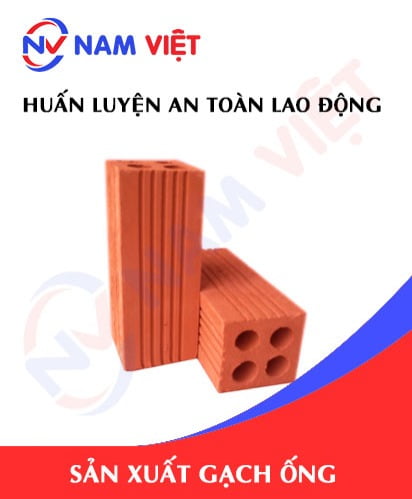Occupational safety training for hollow brick production
99,000 ₫
Note: The above price is calculated per person; prices may vary depending on the number of trainees participating in the course and market fluctuations. For more accurate price support, please refer to the pricing table or contact our consultants directly.
Occupational safety is an important issue in hollow brick manufacturing factories and needs to be addressed promptly to ensure the health and safety of workers, enhancing the reputation of businesses. The Occupational Safety Training course is one of the effective solutions to raise awareness on preventing occupational accidents for workers involved in hollow brick production.
Table of Contents
Toggle1. Overview of Hollow Bricks
a. What are hollow bricks?
- Hollow bricks are a type of rectangular-shaped brick, made from lightweight concrete, clay, or fly ash (unburnt bricks), which can be used to build retaining walls, partition walls or structures requiring sound insulation and thermal insulation properties. They are manufactured in various ways, including firing with heat, high-pressure material compression, or concrete bonding. Hollow bricks are commonly used in civil and industrial construction projects.
- Currently, the hollow brick manufacturing industry in Vietnam is developing quite actively, meeting the needs of both domestic and international markets. Hollow brick manufacturing companies in Vietnam can be divided into two groups: large-scale manufacturers and small-scale manufacturers.
- The group of small-scale manufacturers includes private enterprises or cooperatives that produce hollow bricks. These businesses are often smaller in scale, use simpler technology, and produce basic types of hollow bricks.
- However, there are still some issues in the hollow brick manufacturing industry in Vietnam, such as: product quality differences, lack of investment in research and technology development, and inadequate labor safety.

b. Types of Hollow Brick Production Machinery
There are many types of machinery used in the hollow brick production process, depending on the technology and production scale of each company. However, the most basic machines for producing hollow bricks include:
- Pressing machine: Used to press a mixture of clay and other raw materials into the brick mold to create the desired shape and size.
- Cutting machine: Used to cut hollow bricks into fixed-length sections.
- Drying machine: Used to dry hollow bricks after pressing and cutting to ensure the product’s solidity and durability.
- Polishing machine: Used to polish the surface of hollow bricks to create a smooth and shiny finish for the product.
- Logo printing machine: Used to print logos, brand names, images, or other information on the surface of hollow bricks.
In addition, large-scale companies that use more modern technology also use other equipment and machinery such as grinding machines, mixers, measuring machines, processing machines, air compressors, steam compressors, steam generators, kilns, and product quality testing equipment.

c. Typical Hollow Brick Production Companies
Currently, there are many hollow brick manufacturing companies in Vietnam with different scales and product qualities. Here are some typical hollow brick production companies in Vietnam:
- Dong A Production-Trading-Service Co., Ltd.: A pioneer in the field of hollow brick production and business in Vietnam. Established in 1995, Dong A has over 25 years of experience in producing and supplying hollow bricks with various designs and sizes.
- Phuc Thinh Hollow Brick Production-Trading-Service Co., Ltd.: Established in 2007, Phuc Thinh is one of the large-scale hollow brick manufacturing companies in Vietnam. Phuc Thinh’s products are produced on a modern technology line and meet high-quality standards.
- Van Phuc Production-Trading-Service Co., Ltd.: A pioneer in the field of hollow brick production in Vietnam. Van Phuc’s products are manufactured on a modern line and meet many different quality standards.
- Cuong Thinh Phat Production-Trading-Service Co., Ltd.: A company with many years of experience in producing and supplying hollow bricks in Vietnam. Cuong Thinh Phat’s products are diverse in designs and sizes, meeting many different customer needs.
- Vietnam Energy Joint Stock Company: One of the large-scale hollow brick manufacturing companies in Vietnam. Vietnam Energy’s products are produced on a modern technology line, meet many quality standards, and have been exported to many different markets around the world.
d. Specific Jobs in a Hollow Brick Production Factory
Group 1
- Executive director, deputy executive director, department head in a hollow brick production factory.
Group 2
- Safety officer: manages safety in the factory, designs safety procedures, and supervises and urges employees to comply with safe work procedures.
Group 3
- Raw material preparation: This is a crucial step to produce quality hollow bricks. The main raw materials include clay, kaolin clay, spongy clay, various additives, and water.
- Raw material mixing: The raw materials are put into mixers to be evenly mixed. The mixing process must ensure the correct ratio and quality of materials to ensure the quality of the hollow bricks.
- Pressing into hollow shapes: The raw materials are pressed into hollow shapes using specialized pressing machines. Typically, the output of the pressing machine is long, tapered, or square-shaped hollows.
- Drying: After being pressed into hollow shapes, the bricks need to be dried. The drying process usually uses a drying kiln, where the bricks are placed on racks and dried for a certain period.
- Firing: The firing process is the final step to create the finished hollow brick product. The bricks are put into a kiln and fired at a high temperature for a certain period. After this process, the bricks will have a certain color and hardness.
- Transportation and stacking in the warehouse: After the finished brick products are ready, they will be taken to the warehouse, or transported from the warehouse to stores and construction sites.
Group 4
- Office jobs, serving, sales, marketing.
- Production management, quality management, human resource management, material management, financial accounting management.

2. Overview of the Hollow Brick Production Labor Safety Training Course
Within the scope of this article, we focus on issues surrounding Group 3, because Group 3 is the group directly involved in the production process and bears the highest risk of labor accidents. Refer to other groups here
a. What is Group 3 Labor Safety Training?
- Labor safety training for Group 3 consists of sessions that provide awareness on how to prevent labor accidents for workers.
- The labor safety training course will help workers identify and prevent dangers, and limit the risks of labor accidents while working.
REGISTER FOR LABOR SAFETY TRAINING SERVICE
b. Training Duration
Initial safety training duration
- The total training duration is at least 24 hours, including the test time.
- 8 hours of theoretical study on the system of policies and laws on labor safety and hygiene
- 8 hours of theoretical study on basic knowledge of labor safety and hygiene
- 4 hours of theoretical study on specialized training content
- 2 hours of practical training on specialized training content
- 2 hours of theoretical testing at the end of the training course
The safety training center will distribute the time into several training sessions depending on the time arrangement for employees. But normally, there will be 6 training sessions, the course will take place over 3 days, provided that the manufacturing company can arrange continuous study time.
Periodic safety training duration
- Before the labor safety card expires, if workers want to have it reissued, they must undergo a periodic labor safety training course, with a periodic safety training duration of at least 50% of the initial safety training duration.
Explanation: The total periodic labor safety training duration is at least 12 hours, including the test time. After completing the periodic training course and passing the test, the worker will be re-issued or have their labor safety card renewed.
c. Content of the training course
| No. | TRAINING CONTENT | TRAINING DURATION (HOURS) | |||
| Total | Of which | ||||
| Theory | Practice | Test | |||
| I | System of policies and laws on labor safety and hygiene | 8 | 8 | 0 | 0 |
| 1 | Overview of the system of legal normative documents on labor safety and hygiene. | 6 | 6 | ||
| 2 | System of technical standards and regulations on labor safety and hygiene. | 1 | 1 | ||
| 3 | Specific regulations of state management agencies on labor safety and hygiene when building new, expanding or renovating works, facilities for manufacturing, using, preserving, storing and inspecting types of machines, equipment, materials, and substances with strict requirements on labor safety and hygiene. | 1 | 1 | ||
| II | Basic knowledge of labor safety and hygiene | 8 | 8 | 0 | 0 |
| 1 | Basic knowledge of dangerous and harmful factors at the workplace. | 4 | 4 | ||
| 2 | Methods of improving working conditions. | 1 | 1 | ||
| 3 | Safety culture in production and business. | 1 | 1 | ||
| 4 | Rights and obligations of employers, employees; policies and regimes on labor safety and hygiene for employees; functions and duties of the labor safety and hygiene network. | 1 | 1 | ||
| 5 | Labor safety and hygiene regulations, safety signs, safety instructions and the use of safety equipment, personal protective equipment; first aid skills for labor accidents, and prevention of occupational diseases. | 1 | 1 | ||
| III | Specialized training content | 6 | 4 | 2 | 0 |
| General knowledge about types of machines, equipment, and substances that generate dangerous and harmful factors; analysis, assessment, and management of risks to labor safety and hygiene, safe working procedures with machines, equipment, and substances with strict requirements on labor safety and hygiene. | 6 | 4 | 2 | ||
| IV | Labor safety training test at the end of the training course | 2 | 2 | 0 | 0 |
| Total | 24 | 22 | 2 | ||
See more training content for 6 groups
d. Labor Safety Card
After completing the labor safety training course and passing the test, the worker will be issued a labor safety card (in practice, it is often called a Group 3 labor safety certificate).
The group 3 safety card will clearly show information such as: full name, date of birth, specific job and working environment. It also includes the training duration, red stamp, and signature confirming the completion of the training course.
According to the regulations on issuing safety cards specified in Clause 2 of Article 24 of Decree 44/2016/ND-CP, there are two cases:
- Case where the employer and the employee have a labor contract with each other, the employer must sign, stamp, and seal the safety card for the trained person in Group 3 after they have gone through the training course from a labor safety training unit and passed the test.
- Case where the worker is a freelancer, seasonal worker, and does not have a labor contract, the training unit must sign, stamp, and seal the safety card for the worker after they have gone through the training course from a labor safety training unit and passed the test.

3. Recognizing Dangers in Hollow Brick Production
Some dangers that can occur during the hollow brick production process include:
- Machinery in hollow brick factories, such as mixers, pressing machines, and kilns, can be dangerous to workers, causing serious accidents, explosions, collisions, crushing, and injuries from machine parts.
- Hollow brick production can use many types of chemicals such as cement, sand, limestone, and other chemicals. Prolonged exposure to these chemicals can be harmful to the health of employees, causing allergies, lung inflammation, cancer, and can cause damage to the skin, eyes, respiratory system, and digestive system.
- Hollow brick factories often use complex electrical systems and require specialized knowledge. Contact with high voltage or electrical equipment can cause accidents and injuries.
- The production of hollow bricks can also cause environmental pollution, including exhaust gas and wastewater.
- The risk of injury from falling bricks due to high stacking.
4. Common Labor Accidents in Hollow Brick Production
Common labor accidents during the hollow brick production process may include:
- Injuries from collisions, cuts, scratches: Employees can be injured by tools, machinery, and equipment used during the hollow brick production process.
- Risk of dust and chemical contamination: Dust and chemicals used during the hollow brick production process can be harmful to the health of employees, especially when inhaled for a long time.
- Serious accidents: Equipment and machinery in hollow brick factories can cause serious accidents such as collisions, explosions, fires, etc.
- Back pain and related health problems: Workers in hollow brick factories often have to work in a humid and dusty environment, causing stress and back pain.
- Falling accidents: finished brick blocks are often stacked high in warehouses, and carelessness can cause them to tilt and fall on workers, causing injuries and fatalities.
5. Safety Measures When Participating in Hollow Brick Production
Hollow brick production is a job with a high risk of labor accidents. To ensure worker safety, safety measures must be applied. Safety measures when participating in hollow brick production may include:
- Workers should wear helmets, safety glasses, respirators, and safety shoes when working.
- Employees need to be fully trained in labor safety before starting work.
- Workers must be trained to use machinery correctly, comply with safety regulations, and regularly maintain machinery.
- Machinery and equipment need to be checked periodically to ensure safety during use.
- Workers need to be instructed on how to safely store materials such as cement, sand, and limestone to avoid unnecessary accidents.
- Workers need to have high skills and concentration to avoid accidents caused by human error.
- The production area needs to be reasonably arranged, ensuring there are no objects in the way or causing obstruction.
- The production area needs to be clean, free of dust and dirty air to ensure the health of workers.
- Periodically organize work environment monitoring in factories and enterprises, collect and analyze harmful factors for workers, thereby adjusting to reduce the level of harm to prevent occupational diseases for them.

6. Benefits of Labor Safety Training for Hollow Brick Production
An Toan Nam Viet provides your business with great benefits after completing labor safety training courses as regulated in Decree 44/2016/ND – CP on labor safety and hygiene, for companies, factories, and enterprises.
- Workers can identify the potential risks of labor accidents and from there, have preventive measures to avoid labor accidents.
- Your business can establish risk prevention measures in the production, operation, and maintenance processes.
- Minimize costs when unsafe situations occur in labor.
- Uninterrupted production processes will help increase labor productivity and product quality.
- Comply with labor safety laws, avoiding legal risks.
- Create a reputation and professionalism in all aspects, thereby enhancing the brand for your business.
Nam Viet’s training courses are the solution to prevent and combat external factors that affect each individual so that they can avoid danger that can lead to injury or more seriously, death.
REGISTER FOR LABOR SAFETY TRAINING SERVICE
7. Customer Feedback after Completing the Hollow Brick Production Labor Safety Training Course
An Toan Nam Viet has many years of experience in the mission of accompanying many businesses in Vietnam in general and in the southern provinces in particular. And that responsibility is something extremely precious to Nam Viet, which is why Nam Viet’s Labor Safety Training work is always focused on being more and more professional. And the motivation for An Toan Nam Viet to grow strong to the present comes from the positive feedback and suggestions from the businesses. Below are the responses from our partners whom we have served.
Bac Nam E&C Investment and Construction Joint Stock Company
“The first time I used the service at An Toan Nam Viet I was very surprised by the enthusiastic 24/7 support of the consulting team. The class organization was very fast and convenient for our company, thank you very much for Nam Viet’s service!”
Hoa Dat Construction and Trading Joint Stock Company
“Nam Viet’s service has helped us a lot in simplifying labor safety and the process of completing safety records for our work. The consulting team is enthusiastic and timely in answering our questions. 5 stars for Nam Viet”
See more customer interviews after using An Toan Nam Viet’s service
8. An Toan Nam Viet’s Labor Safety Training Capacity
An Toan Nam Viet is a reputable and quality labor safety training center in Vietnam today. With labor safety training sessions taking place continuously at production workshops, factories or construction sites across the country (63 provinces in Vietnam).
REGISTER FOR LABOR SAFETY TRAINING SERVICE
Labor safety training license
- An Toan Nam Viet has been inspected and licensed by the Department of Labor Safety of the Ministry of Labor – Invalids and Social Affairs, which issued a certificate of eligibility to operate in labor safety and hygiene training. This further strengthens our capacity for labor safety training.

Documents and lectures
- Before the labor safety training documents are put into the labor safety training courses, they have been reviewed and approved to ensure that the lectures are accurate in knowledge and effective when applied.
- The teaching method of the lecturers is synchronized according to the teaching standards of An Toan Nam Viet, which is a method that experts in labor safety and hygiene training have researched and concluded during the teaching process to bring the highest knowledge absorption efficiency to students.
Facilities
- Controlling the factors in the classroom that affect the training process will increase the teaching performance and the knowledge absorption efficiency of students.
- Our facilities to support the training course always arrange spacious classrooms that meet the standards of area, lighting, training equipment, etc.
9. Reputable and quality national safety training center
At An Toan Nam Viet, we always put our professional dedication to labor safety training first. For us, imparting the knowledge of self-protection to workers so that they can have a safe luggage on their path of livelihood is a contribution to building the country.
To ensure effective training, we prepare carefully and meticulously every little detail, even the smallest. From preparing tools, equipment, teaching aids to textbooks, documents, sound, and lighting.
Our labor safety training lecturers are experts with many years of experience in the field. They even have research projects identifying the hazards in all occupations and how to prevent them.
The lecturers’ lessons are summarized from practice and conveyed in the most vivid and easy-to-visualize way to workers. Those factors help workers feel comfortable during their study time and absorb our teaching knowledge well. Of course, the knowledge conveyed always closely follows Decree 44/2016/ND-CP.
From there, they grasp many measures to prevent danger and how to protect themselves. At the same time, they also apply it in the most appropriate way in their actual work.
Our safety training center is proud to be a reputable and professional provider of labor safety training services with the following advantages:
- Competitive training costs but guaranteed training quality.
- Flexible training schedule to match the production situation of the company.
- Fast and legally compliant procedures for issuing labor safety training certificates.
- The training lecturers are people with many years of experience in the profession.
- The classroom is controlled for factors affecting the training process, which increases the teaching performance and knowledge absorption efficiency of students.
- The lectures are compiled to be suitable for labor safety work at businesses.
- An Toan Nam Viet works with dedication and professionalism to support customers accurately and as quickly as possible.

10. Refer to more Hollow Brick Production Labor Safety Training Documents
- Hollow brick production labor safety documents
- Labor safety training documents
- Set of labor safety training test questions
- Hollow brick production labor safety multiple-choice test
- Slides for hollow brick production labor safety training lectures
11. Hollow Brick Production Labor Safety Training Activities
1 review for Occupational safety training for hollow brick production
No comments yet















namchinh.haiphong341
Cảm ơn trung tâm! tôi rất hài lòng với dịch vụ